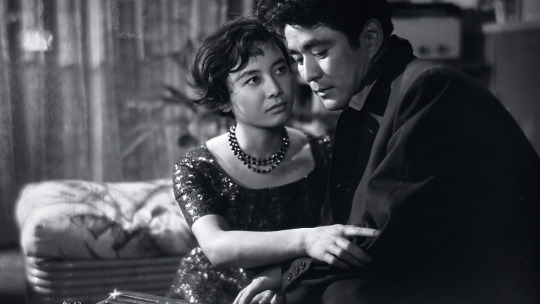
The Balloon (1956) was made at the height of Yuzo Kawashima’s powers and during his most prolific period while working at Nikkatsu studio. The Balloon has all the hallmarks of a Kawashima picture, from its intimate close-ups and two-shot compositions to its tender themes of mercy, compassion, and kinship. Kawashima, like Ernst Lubitsch, had a knack for flawlessly balancing the satirical and the melodramatic with light comedy and a sense of whimsy.
Kawashima’s abilities to handle tonal shifts was his greatest asset in terms of adapting Jirō Osaragi’s novel for the screen. The plot of both the book and the film hinges on the insensitive womanizing of Keikichi (Tatsuya Mihashi) whose exploits drive Kumiko (Michiyo Aratama) to suicide. The Balloon focuses on how Keikichi’s affairs and Kumiko’s death prompt Keikichi’s family to re-evaluate their lives and change them.
The Balloon, in its very structure, is a complex of contrasts. Kawashima juxtaposes Keikichi with his more compassionate father Haruki (Masayuki Mori). Theirs is a conflict of generations à la Ozu. But Kawashima also establishes Kumiko and Keikichi’s new mistress, Mikiko (Mie Kitahara), as two sides of the same social coin. While all these differences make for terrific melodrama, the heart of The Balloon resides in the relationship formed between Keikichi’s little sister Tamako (Izumi Ashikawa) and Kumiko.
Visually the images of these contrasting characters rhyme; reflecting one another and unifying them into sets via compositional similarities. But the images of Tamako and Kumiko are wider compositions that encompass both figures. They are unified in a single frame as well as thematically as two unwanted people. For Tamako, Kumiko is her first ever friend and Kawashima prioritizes this fact, filling their scenes with a loving exuberance that has been rarely matched in the cinema.
In just seven years after the release of The Balloon Yuzo Kawashima would be dead at the age of forty-five. However, Kawashima’s influence in Japanese cinema has been considerable. As a contemporary of filmmakers like Kon Ichikawa, Kawashima was a direct influence on Nagisa Ōshima and Shōhei Imamura; particularly the latter’s film The Eel (1997). The Balloon is Kawashima at his most human and is essential to any connoisseur of Japanese cinema.
